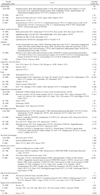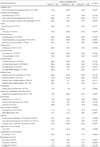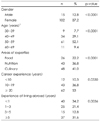Abstract
Han-sik is a term in Korean that may indicate any Korean dish or food. At present, there is no general consensus on the definition of Han-sik among scholars or professionals in related fields. The aim of this study was to investigate perceptions of Han-sik by professionals in the fields of food, nutrition, and culinary arts using 512 dishes and foods commonly consumed by Koreans using the 4th Korean National Health and Nutrition Survey. A total of 117 professionals out of 185 initially contacted professionals participated in this online survey. We calculated the rate of respondents with a positive answer, that is "It is Han-sik', on each dish and food from the 512 items in 28 dish groups. Items were categorized into five groups according to their Han-sik perception rate: over 90%, 75-89%, 50-74%, 25-49%, and below 25%. Most items in the three dish groups 'Seasoned vegetables, cooked (Namul·Suk-chae)', 'Kimchis', and 'Salt-fermented foods (Jeotgal)' showed high perception rates of Han-sik, with a higher than 90% positive response. Items in 'Soups', 'Stews', and 'Steamed foods' dish groups also showed high perception rates of Han-sik. However, no item showed a greater than 90% Han-sik perception rate in 'Fried foods (Twigim)', 'Meat, poultry and fishes', 'Legumes, nuts, and seeds', 'Milk and milk products', 'Sugars and confectioneries', and 'Soup'. Most items in the 'Milk and milk products', 'Sugars and confectioneries', and 'Soup' groups belonged to the lowest perception rate of below 25%. There was a significant difference in the proportion of items perceived as Han-sik by the length of living abroad to (p < 0.05). In summary, the perception rate of Han-sik seemed to be affected by the cooking method, ingredients, and length of time living abroad by the professionals. Further studies targeting subjects with different characteristics and socioeconomic status are warranted to define the concept of Han-sik.
Figures and Tables
Table 3
List of seasonings and commercially prepared and non-cooked foods by Han-sik perception rate

Table 4
Dish and food items that showed significant difference in Han-sik perception rate by respondent's areas of expertise

References
1. Cho HY. The historical background and characteristics of Korean food. Korean J Diet Cult. 1998. 13(1):1–8.
2. Lee MJ, Popkin BM, Kim S. The unique aspects of the nutrition transition in South Korea: the retention of healthful elements in their traditional diet. Public Health Nutr. 2002. 5(1A):197–203.

3. Moon HK. Seminar for Korean food culture/the standardization of Korean diet for globalization of Korean food. Food Sci Ind. 1994. 27(2):38–54.
4. Moon HK, Chung HR, Cho EY. Analysis of menu patterns from the Korean national nutrition survey in 1990. Korean J Diet Cult. 1994. 9(3):241–250.
5. Kim KO, Lee SK, Kang JH, Kim YS, Kim JS, Kim HR, Kim HS, Moon HK, Park YH, Baik HW, Son JW, Song WO, Ok SH, Lee KI, Lee SY, Joung HK, Choi JH. Hansik and health. 2010. Suwon: National Academy of Agricultural Science.
6. Choi J, Moon HK. Dietary pattern by sex and age with menu an-alysis using 1998, 2001 national health and nutrition survey of Korea. Korean J Community Nutr. 2007. 12(6):798–814.
7. Cho MS. A study of intakes of vegetables in Korea. Korean J Food Cult. 2003. 18(6):601–612.
8. Chang HJ, Choi BR, Yi NY, Park BS, Kim HS. Preferences and product development opinions of Koreans and non-Koreans regarding commercialization of Korean foods. Korean J Food Cookery Sci. 2010. 26(4):458–468.
9. Lee JM, Oh SY. Traditional and mordern food use in Korean adults in Seoul. Korean J Diet Cult. 1996. 11(2):147–154.
10. Jung HJ, Moon SJ, Lee L, Yu CH, Paik HY, Yang IS, Moon HK. Evaluation of elementary school lunch menus based on maintenance of the traditional dietary pattern. Korean J Nutr. 2000. 33(2):216–229.
11. Moon HK. Analysis of menu in school food service: comparing the use of traditional menu between 1995 and 2001. J Korean Diet Assoc. 2003. 9(1):47–56.
12. Bae YM, Song DH, Ahn HS. Perceptions of traditional Korean foods and satisfaction levels toward school foodservice among middle school students and parents of schools serving traditional Korean menus in Gyeonggi province. J Korean Diet Assoc. 2011. 17(2):118–129.
13. Kim JH, Lee JE, Yoon JH, Lim YS, Yoo JY, Jung IK. Perceptions of Korean traditional foods by junior high school students and their parents in Gyoenggi province of Korea. Korean J Community Living Sci. 2008. 19(1):63–74.
14. Hong H, Kim JY, Lee JS. Survey on Korean food preference of college students in Seoul: focused on side dishes. Korean J Nutr. 2006. 39(7):707–713.
15. Moon SJ, Song JS. Study on food quality of Korean restaurants, customer satisfaction, and revisit intentions in Chinese university or college students - focused on different awareness of Korean food -. Korean J Food Cult. 2012. 27(3):258–293.

16. Kim TH, Lee EJ, Lee EJ. A study on perception and globalization of Korean food among university students with food-related majors. Korean J Food Cult. 2009. 24(6):597–606.
17. Lee BS, Park HJ, Jung JW. A study on the difference of perception about traditional food by generations in Busan area. Korean J Culinary Res. 2010. 16(4):1–14.

18. Choe JS, Park HS, Park S, Lee J, Kang M. Development of evaluation indicators for industrialization of local cuisine. Korean J Food Cult. 2012. 27(3):233–239.

19. Cha SM, Chung L, Chung SJ, Kim KO, Lee SR, Kim HR, Han GJ, Lee JY. Comparative analysis on preference for Korean traditional foods in foreigners and Koreans. Korean J Food Cult. 2012. 27(3):294–303.

20. Kim J. Universalizing Korean food. Korean J Food Cult. 2005. 20(5):499–507.
21. Park YH, Kang M, Baik HW, Oh SW, Park SJ, Paik HY, Choe JS, Lee JY, Kang MS, Joung H. A study on the perception as HANSIK (Korean food) for the common dishes in Korean adults residing in Seoul and metropolitan area. Korean J Community Nutr. 2012. 17(5):555–578.

22. Lee EH. The development of the modern Korean sugar consumer culture. J Korean Hist. 2012. (157):191–223.




 PDF
PDF ePub
ePub Citation
Citation Print
Print





 XML Download
XML Download